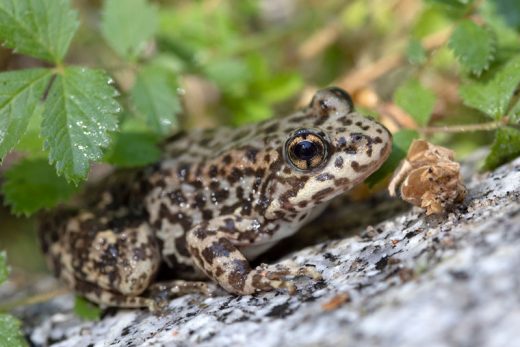
Photo by Christina Simmons, San Diego Zoo Global ©
The San Diego Zoo Global, a not-for-profit organization that operates the San Diego Zoo and the San Diego Zoo Safari Park, continued its efforts to restore a stable and thriving population of Mountain Yellow-legged Frogs (MYLF) in the San Jacinto Mountains.
Earlier this month, a team of scientists, led by Dr. Debra Shier, associate director for the Conservation Research Division of the San Diego Zoo, released 87 tadpoles and 30 adults into the Stone Creek habitat.
“The good news is we’re making progress,” Shier said.
Last year, many tadpoles were released. Shier was happy to discover many had survived the winter and evolved into juvenile frogs on the mountain.
“Tadpoles are the risky stage,” she stated. “Once they can get through tadpole to juvenile, they are more likely to survive … if hundreds of tadpoles are released, we rarely saw any juveniles.”
This is one reason the zoo is keeping the tadpoles until they become juveniles. She did say, there is one adult that was released in 2016 that is doing well.
To assign success to the reintroduction of a species, Shier described four steps that need to be successfully achieved.

First, the species must settle into the release site. Second, scientists verify if the species survived at the location. Next, the population must begin to grow beyond the numbers released. Finally, success means there is a viable and stable population.
The MYLF doesn’t reproduce until its third or fourth year, according to Shier. “So we have a couple more years [to wait],” she added. “But they have amazing reproductive output.
“For each individual that survives, it makes an exponential difference in the species’ recovery,” she said.
This year, in collaboration with the U.S. Geological Survey, the zoo was able to develop transmitters small enough to be implanted in the frog’s tissue.
Transmitters have been used in the past, but they had to be applied to the frogs skin, and often fell off, as the frogs moved through the stream habitat.
The frogs are not big so an on-site survey of the population often missed many which were able to hide under rocks or in crevices.
These improved transmitters will help the zoo collect valuable data on the MYLF’s activities. Shier hopes the data will let them know how the frogs settle in the winter, how much of the habitat they use, and which release sites most benefit the population.
The transmitters will have enough power to send signals during the winter and possibly into the spring.
While the drought years earlier in the decade posed a challenge for the MYLF’s survival, this year looks positive. “There is a lot of water still in the creeks this late in the summer,” she said.
Over the past 40 years, the MYLF population steadily declined due to multiple factors including habitat loss, drought, introduced predators (trout), pollution and the deadly amphibian disease chytridiomycosis, caused by the chytrid fungus. The frog population numbers fell so dramatically that the species was listed as endangered, under the Endangered Species Act.
Staff from the San Diego Zoo’s Institute for Conservation Research has been working to restore the MYLF population for more than a decade. In 2006, scientists collected Mountain Yellow-legged Frog tadpoles from the remaining wild populations in the San Jacinto Mountains and took them to the zoo’s institute where, for the first time, specialists were able to establish a captive breeding program for the species.
The success of the captive breeding enabled a release of tadpoles in 2010.










